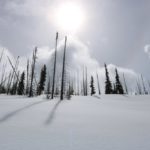The Backcountry
Posted: June 5, 2017Source: The Forest Blog
By Russ Vaagen
Beautiful Places

Regardless of the type, we should use collaboration to identify these areas that haven’t already been designated. You may wonder why we are going from Active Management in a previous blog post, directly to Backcountry. During collaborative work within the Northeast Washington Forestry Coalition we have found that by focusing efforts on the two bookends, the middle section (Conservation Management) shows itself.
So, how do we identify these areas? The most obvious place to start is already designated wilderness or other protected areas like monuments. Since these places are already identified and designated by Congress or presidential proclamation, there isn’t much need to discuss them. Other prominent areas would be identified as Inventoried Roadless Areas (IRA). Many IRA’s have been designated as not having roads in a minimum of 5,000 contiguous acres. Not all, but many have a high consensus about the need for protection.
Each IRA needs to be individually listed and discussed by the collaborative group. It’s useful to identify the appropriate potential designation (wilderness, backcountry motorized, backcountry non-motorized). Discussions within the group should focus on firsthand knowledge of the area. Describing what they know about it and what their interests are there.
Interests rather than Positions
It’s always useful to start out with interests rather than positions. If a conservation group representative says, “Our position is that this IRA needs to be wilderness,” it can put users at odds. Even if someone else wants it protected, but wants to continue mountain biking on existing trails the two participants are immediately at odds. It would be much better to have a conservation group representative say, “We hike and camp here yearly. It’s vital to our group and others that use it. Our interest is to see that the area is protected from development.”
Using the second approach allows for discussion between the groups. Finding these interests is important for a couple of reasons. First, that it gives the others in the group the chance to learn about areas they don’t know well. Second, it allows group members space for discussion and future negotiation.
Trust and empathy are critical. Once trust is developed, the discussion can be very productive. Checking in with everyone about each IRA is important. This is a good spot to have a simple vote on what each IRA could become. Should it be wilderness? Protected, but allow the use of mountain bikes? Prevent extensive future development, but continue to encourage the use of motorized recreation on designated trail systems?
Pick Low-Hanging Fruit First
This should give the group an opportunity to see where they stand. Providing everyone the first glance of where consensus is likely, possible, or contentious. Even identifying disagreement within the group is helpful at this stage. The focus should move to the IRA’s where the most agreement is present. Good discussion and eventual consensus will help build trust. This will serve the group well when discussing more contentious areas.
Three Critical Backcountry Points
In my experience, there are three important issues to address while conducting these discussions.
- Recreation
- Frequently where people love to recreate, and future considerations impact users of all types.
- Grazing
- Many of these areas have active grazing allotments that operate under special use permits.
- Finding common ground with the grazing community should be the goal of any collaborative group.
- Land Designations
- Each designation carries with it different restrictions and opportunities.
- All current and future potential land uses should be reviewed before moving toward USFS designation and legislation.
Once consensus is reached on all or some of the identified backcountry, the next likely step is to connect with USFS if they weren’t part of the process. Once all are on the same page, the next level is potential legislation.
Most people get caught up in the backcountry being either wilderness or not. An opportunity exists to have at least two new designations. Both would be backcountry, one is non-motorized, and the other is motorized. This way we could develop permanent land designations that protect the interests of many other users of the forest.
With productive, healthy dialog we can address these important issues. And in time learn to appreciate and use the land with a sense of permanency for many years to come.
